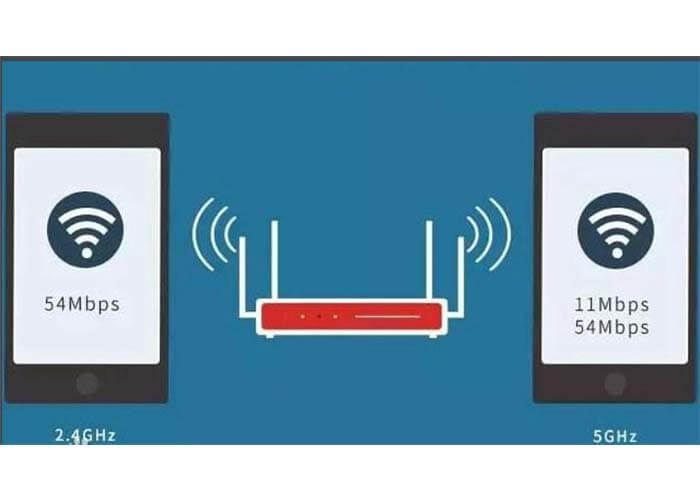Someone bought a new router and found that there is two wireless WiFi, one of which shows that there is 5G, we know that the ordinary wireless WiFi band is 2.4GHz, so this 5G wifi and 2.4GHz where are the differences? 5GHz and 2.4GHz and what are the differences?
2.4GHz VS 5GHz WiFi comparetion
2.4GHz and 5.0GHz are the working bands of wireless routers, and their specific differences are as follows.
Nature difference
2.4GHz band has good performance through the wall, but the bandwidth is relatively narrow, and it is easy to drop out when multiple peripherals are accessed.
5.0GHz is a high-frequency channel band, with large bandwidth and good stability. It is not easy to drop out when multiple peripherals access, but its wall penetration ability is weaker compared with 2.4GHz.
Functional difference
At this stage, most of the electronic products use the 2.4GHz band, general cell phones, and wireless network cards basically support 2.4GHz, because there are many devices using 2.4GHz, so it is easy to generate interference.
5GHz is the WiFi band, the current environment with fewer devices, interference is also relatively less.
Device difference
Dual-band wireless router works in 2.4GHz and 5GHz modes at the same time, the single-band wireless router use mode can only be in 2.4GHz mode.
What is 5G wireless WiFi?
The 5G wireless WiFi (802.11ac) refers to the fifth generation of wireless WiFi transmission technology and operates in the 5Ghz radio waveband (the G here is not the 3G or 4G network on the wide-area network we are talking about). Most of our current wireless WiFi utilizes the 4th generation 2.4GHz.
In layman’s terms, we can imagine the 2.4GHz band and the 5GGz band as a highway, and to get on this road, we have to follow the rules of the road. Because the 2.4GHz highway, not only the speed limit is only 60, and in addition to wireless WiFi, wireless mouse, keyboard, headphones, and other wireless devices are used in this band, think about how many such wireless devices around, you know how crowded it is.
And next door on this 5Ghz highway, not only good road conditions, and speed limits to 200, not up to the requirements of the road at all, now eligible for the road is not much car, so this road is now very little car.
It is easy to have a misunderstanding that wireless WiFi running in the 5GHz band is 5G wireless WiFi, in fact, it is not.
Wireless WiFi protocol standards running in the 5Ghz band include 802.11a (first generation), 802.11n (the fourth generation, running in both 2.4GHz and 5GHz dual-band), and 802.11ac (fifth generation), and only wireless WiFi with 802.11ac protocol is the real 5G wireless WiFi).
What are the benefits of 5G wireless WiFi?
Have a faster network and take care of congestion
Now the world’s fastest wireless WiFi transmission speed is only 300Mbps (a few can reach 600Mbps), which is equivalent to only about 36MB of content per second, and this speed is no longer enough for today’s needs.
And under the LAN through the 5G wireless WiFi router copy a 500MB file to the phone, repeat 5 times, calculate the average, the results than the 2.4GHz wireless WiFi devices to be about twice as fast, such as S4 for 4.66 MB / s, S3 peak 2.53 MB / s (broadband, router configuration is not the same, the actual results will vary).
Improve playback quality
As the 5G wireless WiFi transmission speed can reach 125MB per second, so not only downloading is faster, but also watching HD videos online is smoother.
More power saving for cell phones
One of the major advantages of 5G wireless WiFi is energy efficiency – because it takes less time to download the same size, and the device can enter low-power power-saving mode more quickly. For example, Broadcom’s 5G wireless WiFi technology allows mobile devices to reduce power consumption rate by 83%, thus extending the usage time of the device.
Better signal quality
As mentioned above, the 5Ghz band is less used in China, so radio interference is greatly reduced and signal quality is naturally better.
However, 5G wireless WiFi also has its disadvantages, such as poor signal penetration.
Although 5GHz is more resistant to interference and transmits more data than 2.4GHz, mainly for non-blocking situations, such as non-through walls, and generally works well within 5-10 meters, but the 5GHz signal propagation ability is worse than 2.4GHz. If the home needs to go through the wall or other electronic devices more, 2.4GHz performance will be better.
How to experience the real 5G wireless WiFi network?
Fiber optic network+5G wireless WiFi router+5G wireless WiFi-enabled mobile devices = true 5G wireless WiFi network
As you can see from the above formula, you can’t experience a 5G wireless WiFi network if you only buy a cell phone that supports 5G wireless WiFi.
Besides the 2.4ghz vs 5ghz wifi article, You may also be interested in the below articles.
What is the difference between WIFI and WLAN?
Summary of 41 Basic Knowledge of LTE
What Is The 5G Network Slicing?

